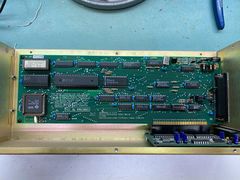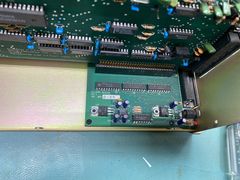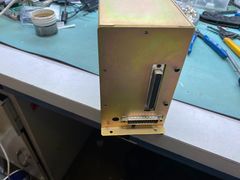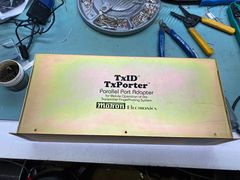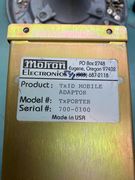Difference between revisions of "Transmitter Fingerprinting"
(Created page with "Category:Transmitter Fingerprinting This is a rather simple concept in that each FM transmitter as it "key's up" will exhibit a unique phase/time response. This is cause...") |
|||
| (3 intermediate revisions by the same user not shown) | |||
| Line 29: | Line 29: | ||
[[Media:Motron TxID-1 Pattent.pdf|Motron TxID-1 Patent]] | [[Media:Motron TxID-1 Pattent.pdf|Motron TxID-1 Patent]] | ||
| − | [[ | + | [[Media:Motron TxID-1 Ad.pdf|Motron TxID-1 Ad]] |
[[Media:An Evaluation of the MoTron TxID-1 Transmitter Fingerprinting System.pdf|An Evaluation of the MoTron TxID-1 Transmitter Fingerprinting System]]. This looks to have a rather complete schematic of the TxID-1 board and ASM code of the code. | [[Media:An Evaluation of the MoTron TxID-1 Transmitter Fingerprinting System.pdf|An Evaluation of the MoTron TxID-1 Transmitter Fingerprinting System]]. This looks to have a rather complete schematic of the TxID-1 board and ASM code of the code. | ||
| − | [[ | + | [[Media:Monitoring-Times-2002-04.pdf|Monitoring-Times-2002-04]] - Page 82 here has a review of the system |
'''If you have a PDF manual Please send it to me, or any other docs'''. EEPROM images would be good to have, as they start going bad about 25 years out. | '''If you have a PDF manual Please send it to me, or any other docs'''. EEPROM images would be good to have, as they start going bad about 25 years out. | ||
| Line 40: | Line 40: | ||
= Xmit_ID = | = Xmit_ID = | ||
| − | This was a C program made for DOS using a sound card to do basically the same thing by Richard Rager, KB8RLN. I messed with this when I was 15 and recall it working well. It didn't have all the functionality of the Motron TxID-1 but for the price, it was hard to beat. | + | This was a C program made for DOS using a sound card to do basically the same thing by Richard Rager, KB8RLN. I messed with this when I was 15 and recall it working well. It didn't have all the functionality of the Motron TxID-1 but for the price, it was hard to beat. He was a [https://www.qsl.net/n9zia/xmit_id/legal.html bit critical] of the patent from Boeing. |
| + | |||
| + | [https://www.legacy.com/obituaries/dispatch/obituary.aspx?n=richard-t-rager&pid=19646525 Unfortunately it looks as if Richard passed in 2006.] | ||
There is a [https://www.qsl.net/n9zia/xmit_id/index.html page on it at qsl.net] | There is a [https://www.qsl.net/n9zia/xmit_id/index.html page on it at qsl.net] | ||
| − | I've mirrored it below | + | I've mirrored most it below. |
| + | |||
| + | == XMID 2.61 == | ||
| + | |||
| + | [[Media:Xmit261.zip|Xmit 2.61 Dos Install File]] for DOS. | ||
| + | |||
| + | [[Media:Xmit-src.zip|Xmit 2.61 Dos C Source]]. This is the source and it GPLv2. | ||
== XMIT_ID== | == XMIT_ID== | ||
| Line 52: | Line 60: | ||
<h1>Xmit_ID version 2.61</h1> | <h1>Xmit_ID version 2.61</h1> | ||
</center> | </center> | ||
| − | + | <p>XMIT_ID allows you to record and catalog the unique | |
"fingerprint" that is part of every FM radio's transmission. | "fingerprint" that is part of every FM radio's transmission. | ||
This can be used for transmitter identification. | This can be used for transmitter identification. | ||
| Line 97: | Line 105: | ||
WARRANTY, even the implied warranty of MERCHANTIBILITY or FITNESS FOR A | WARRANTY, even the implied warranty of MERCHANTIBILITY or FITNESS FOR A | ||
PARTICULAR PURPOSE.</p> | PARTICULAR PURPOSE.</p> | ||
| − | + | ||
<center> | <center> | ||
<p> | <p> | ||
| Line 106: | Line 114: | ||
</p> | </p> | ||
</center> | </center> | ||
| − | + | ||
| − | <br><center>Press <a href="help.html">here</a> for latest XMIT_ID help file in | + | <br><center>Press <a href="https://www.qsl.net/n9zia/xmit_id/help.html">here</a> for latest XMIT_ID help file in |
html</center> | html</center> | ||
| − | <br><center>Press <a href="faq.html">here</a> for the lastest frequently asked | + | <br><center>Press <a href="https://www.qsl.net/n9zia/xmit_id/faq.html">here</a> for the lastest frequently asked |
questions about XMIT_ID. | questions about XMIT_ID. | ||
</center><br> | </center><br> | ||
| − | <br><center><a href="down.html"> | + | <br><center><a href="https://www.qsl.net/n9zia/xmit_id/down.html"> |
Press here to download XMIT_ID version 2.61</a> | Press here to download XMIT_ID version 2.61</a> | ||
</center> | </center> | ||
| − | <br><center><a href="legal.html">Press here</a> to learn more about the | + | <br><center><a href="https://www.qsl.net/n9zia/xmit_id/legal.html">Press here</a> to learn more about the |
background of XMIT_ID.</center> | background of XMIT_ID.</center> | ||
| − | <br><center>Press here for <a href="links.html">LINKS</a> to other amateur | + | <br><center>Press here for <a href="https://www.qsl.net/n9zia/xmit_id/links.html">LINKS</a> to other amateur |
Radio sites.</center> | Radio sites.</center> | ||
<p> | <p> | ||
| Line 129: | Line 137: | ||
</p> | </p> | ||
| − | |||
Page created by: Richard Rager | Page created by: Richard Rager | ||
<br> | <br> | ||
<br>Changes last made on: <i>Nov 15, 2000</i> | <br>Changes last made on: <i>Nov 15, 2000</i> | ||
</html> | </html> | ||
Latest revision as of 19:58, 19 November 2020
This is a rather simple concept in that each FM transmitter as it "key's up" will exhibit a unique phase/time response. This is caused by many things such as a the PLL coming into lock, power amp response and start of audio. The general theory here is this is unique even between different models of the same transmitter.
This is plausible as two way radios typically have a PLL that must lock on frequency and then start transmitting. However some use an always on oscillator, and "key" the power amp. I would be interested how this would work.
The original idea was patented and implemented in the early 90s as an ISA card with a DOS program. This is likely due to the need for real-time audio processing, and ISA for easy interfacing. This was the Motron TxID-1.
Richard Rager produced a set of programs known as XMIT_ID in the mid to late 90's which would do this with a 8 bit sound blaster card. This was software DSP on a 386, very impressive for the time.
Contents
Motron TxID-1
The Motron TxID-1 was about 700 dollars and was based on the original patent. The inventor was was Dr. Philip J. Ferrell, K7PF of Seattle and developed while working for Boeing. He spun it off into Motron Electronics as Boeing had no use for it. Initially this was a ISA board, but they sold an interface to a parallel port, the TxPorter, which you can see in the pictures below.
Link to an archive of their website on the TxID-1
2.95 TxID-1 Software Motron TxID-1 Patent
An Evaluation of the MoTron TxID-1 Transmitter Fingerprinting System. This looks to have a rather complete schematic of the TxID-1 board and ASM code of the code.
Monitoring-Times-2002-04 - Page 82 here has a review of the system
If you have a PDF manual Please send it to me, or any other docs. EEPROM images would be good to have, as they start going bad about 25 years out.
Xmit_ID
This was a C program made for DOS using a sound card to do basically the same thing by Richard Rager, KB8RLN. I messed with this when I was 15 and recall it working well. It didn't have all the functionality of the Motron TxID-1 but for the price, it was hard to beat. He was a bit critical of the patent from Boeing.
Unfortunately it looks as if Richard passed in 2006.
There is a page on it at qsl.net
I've mirrored most it below.
XMID 2.61
Xmit 2.61 Dos Install File for DOS.
Xmit 2.61 Dos C Source. This is the source and it GPLv2.
XMIT_ID
Xmit_ID version 2.61
XMIT_ID allows you to record and catalog the unique "fingerprint" that is part of every FM radio's transmission. This can be used for transmitter identification.
XMIT_ID was created because of the interference problems that plague repeater systems. Finding the people responsible can be very difficult. Yes, you can use "direction finding techniques" to locate them. But, in the case of malicious interference, you need to positively identify the transmitter being used. The answer is to "fingerprint" the radio. XMIT_ID will store and compare the fingerprints of a radio. It records the radio's discriminator audio finger print, then time and date stamps every transmission. This makes XMIT_ID an invaluable tool to anyone having interference problems. This program will help you in gathering evidence to help convict the person(s) responsible. Here are some uses for XMIT_ID:
- To find stolen transmitters.
- To help locate transmitter spurs.
- To help identify illegal users on a repeater.
- To stop cellular phone fraud.
The price of this type of equipment can be out of reach for the average ham. Now with XMIT_ID, and the following equipment list, you can get "Finger Prints" of radios.
- a modified receiver or 9600 baud packet ready radio
- a 386 or better computer
- DOS 5.0-6.22 (Windows 95 needs a lot of tweeking; it can be done)
- VGA monitor
- 1 meg of memory
- Sound card (A real 8 bit Sound Blaster works the best)
XMIT_ID is now GNU GPL licensed and as such is free to download and free to use. You may redistribute it and/or modify it under the terms of the GNU General Public License as published by the Free Software Foundation.
Click here http://www.gnu.org to go to the Free Software Foundation site for details of this agreement.
XMIT_ID is licensed free of charge and is, therefore, distributed WITHOUT ANY WARRANTY, even the implied warranty of MERCHANTIBILITY or FITNESS FOR A PARTICULAR PURPOSE.
XMIT_ID is copyrighted (c) 1995,1998 by Richard Rager Programmer (KB8RLN)
All Copyrights reserved.
Thank Your for the letters of my site being down. Here is what is going on. My old employer was hosting his site actech.net with me and wanted to move it. I have been hosting XMIT_ID there for about 4 years at http://xmit.actech.net. Since I do not have control of the DNS I can not change this. I am trying to get it back up. For now I have a copy at http://xmit.penguinman.com. I own this domain. I will keep it there please update all your links. Please tell other to do so.
Page created by: Richard Rager
Changes last made on: Nov 15, 2000
